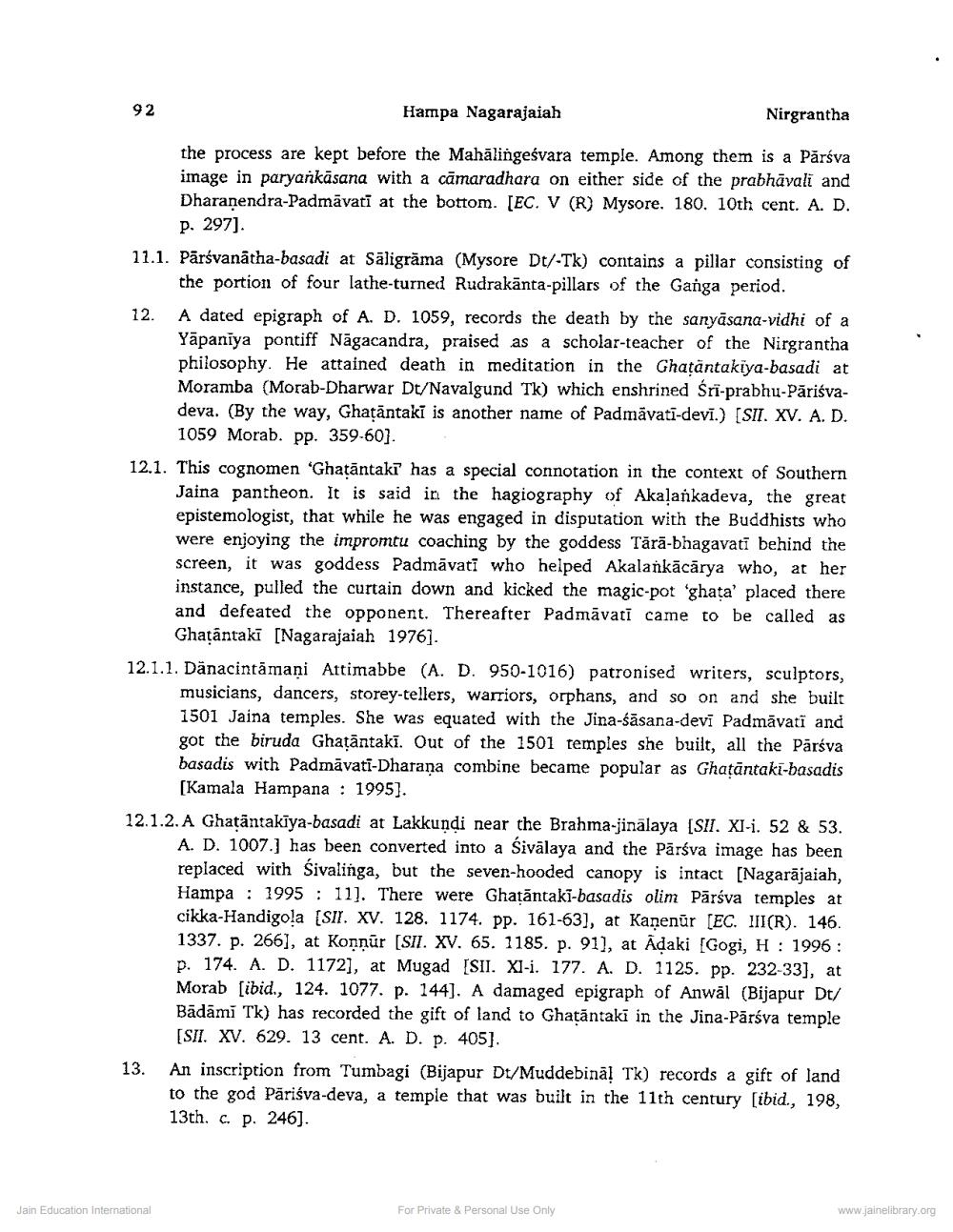Book Title: Jin Parsva and His Temples in Inscriptions of Karnataka Author(s): Hampa Nagrajaiha Publisher: Z_Nirgrantha_1_022701.pdf and Nirgrantha_2_022702.pdf and Nirgrantha_3_022703.pdf View full book textPage 9
________________ 92 Hampa Nagarajaiah Nirgrantha the process are kept before the Mahālingeśvara temple. Among them is a Părśva image in paryankāsana with a câmaradhara on either side of the prabhāvali and Dharanendra-Padmāvatī at the bottom. [EC. V (R) Mysore. 180. 10th cent. A. D. p. 297]. 11.1. Pārsvanatha-basadi at Saligrāma (Mysore Dt/-Tk) contains a pillar consisting of the portion of four lathe-turned Rudrakānta-pillars of the Ganga period. 12. A dated epigraph of A. D. 1059, records the death by the sanyāsana-vidhi of a Yapaniya pontiff Nāgacandra, praised as a scholar-teacher of the Nirgrantha philosophy. He attained death in meditation in the Ghatāntakiya-basadi at Moramba (Morab-Dharwar Dt/Navalgund Tk) which enshrined Śrī-prabhu-Păriśvadeva. (By the way, Ghatāntaki is another name of Padmavati-devī.) [SII. XV. A. D. 1059 Morab. pp. 359-60]. 12.1. This cognomen 'Ghatāntaki has a special connotation in the context of Southern Jaina pantheon. It is said in the hagiography of Akalankadeva, the great epistemologist, that while he was engaged in disputation with the Buddhists who were enjoying the impromtu coaching by the goddess Tārā-bhagavati behind the screen, it was goddess Padmāvati who helped Akalankācārya who, at her instance, pulled the curtain down and kicked the magic-pot 'ghata' placed there and defeated the opponent. Thereafter Padmāvati came to be called as Ghatāntaki [Nagarajaiah 1976]. 12.1.1. Dănacintāmaņi Attimabbe (A. D. 950-1016) patronised writers, sculptors, musicians, dancers, storey-tellers, warriors, orphans, and so on and she built 1501 Jaina temples. She was equated with the Jina-śāsana-devī Padmāvati and got the biruda Ghatāntakī. Out of the 1501 temples she built, all the Pārsva basadis with Padmāvati-Dharana combine became popular as Ghatāntaki-basadis [Kamala Hampana : 1995). 12.1.2. A Ghatāntakiya-basadi at Lakkundi near the Brahma-jinālaya [SII. XI-i. 52 & 53. A. D. 1007.] has been converted into a Sivālaya and the Pārsva image has been replaced with Sivalinga, but the seven-hooded canopy is intact (Nagarājaiah, Hampa: 1995 : 11]. There were Ghaṭāntakī-basadis olim Pārśva temples at cikka-Handigola (SIT. XV. 128. 1174. pp. 161-63), at Kanenur (EC. III(R). 146. 1337. p. 266], at Konnur (SII. XV. 65. 1185. p. 91), at Adaki Gogi, H : 1996: p. 174. A. D. 1172), at Mugad [SII. XI-i. 177. A. D. 1125. pp. 232-33), at Morab (ibid., 124. 1077. p. 144). A damaged epigraph of Anwāl (Bijapur Dt/ Badāmi Tk) has recorded the gift of land to Ghatāntakī in the Jina-Pārśva temple [SII. XV. 629. 13 cent. A. D. p. 405). An inscription from Tumbagi (Bijapur Dt/Muddebinā! Tk) records a gift of land to the god Pāriśva-deva, a temple that was built in the 11th century (ibid., 198, 13th. c. p. 246). Jain Education International For Private & Personal Use Only www.jainelibrary.orgPage Navigation
1 ... 7 8 9 10 11 12 13 14 15 16 17 18 19 20 21 22 23
